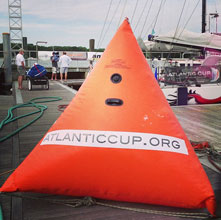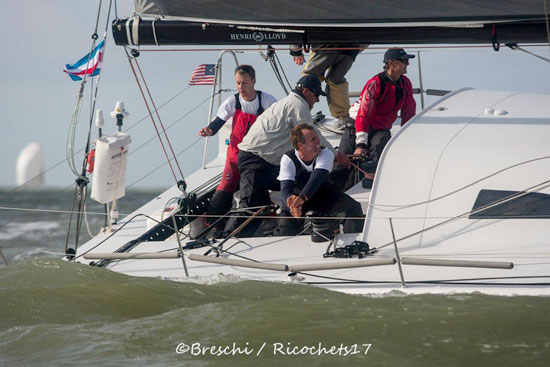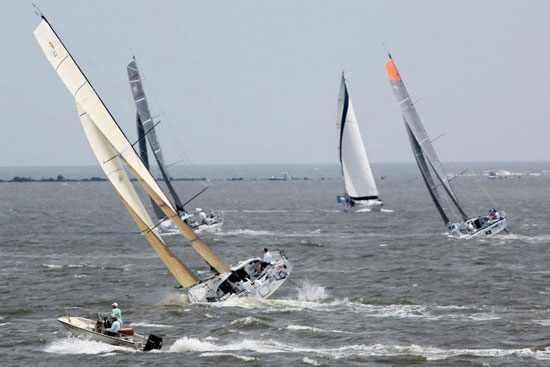It’s Friday in Newport, Rhode Island and the weekend forecast for Leg Three of the Atlantic Cup looks to be for some spectacular sailing … and for some not-so-great weather. Saturday will likely dip into the 50’s with a strong chance of rain, Sunday in the 60’s with a little less rain predicted – and the winds both days up there close to 20 mph. So, it looks to be a challenging and a bit of a wild event for sure.
A number of people have asked me about the difference between “offshore” and “inshore” racing. So, I thought I’d try my hand here at explaining what makes them different … and how inshore action adds to the overall scope and excitement of the competition.
“Offshore” racing is open-ocean racing – from a starting point to an ending point, and it’s what we did on both Leg One (Charleston, SC to NYC/ 640 miles) and Leg Two (NYC to Newport, RI /240 miles) of the Atlantic Cup.
Atlantic Cup Recap of Leg Two – NYC-Newport …
“Inshore” racing is course racing, and it’s what we’re doing this weekend on Narragansett Bay. As it involves so many quick and difficult maneuvers, each of the boats will have up to 6 crewmembers onboard. As Matt Scharl had to take off for the Midwest (Thanks Matt for an incredible job!) for this next leg, I will be joined by Jay Cross, Jay Hansen, Christer Still, Skip Mattos and Ryan Scott – stout-hearted competitors and experienced seamen, each and every one!
There will five races over two days … with all seven boats in each race – and assuming we complete all five races, each team gets to keep their best four finishes. These are typically very short races, 15 miles or so in overall distance on a mapped-out course around a series of buoys in the bay, with the legs themselves often less than 2 miles in length.
 Here’s how the races are set up. There are a number of “marks” of the sort that the government places in harbors everywhere, so that ships and boats can navigate around them and so avoid rocks and shallow areas. These, along with other marks that the race organizers place in the water (like the one to the left,) are all the potential markers for the course.
Here’s how the races are set up. There are a number of “marks” of the sort that the government places in harbors everywhere, so that ships and boats can navigate around them and so avoid rocks and shallow areas. These, along with other marks that the race organizers place in the water (like the one to the left,) are all the potential markers for the course.
At the start of the race, the AC Race Committee notifies us of the particular course they want us to run, and they give us a sheet with all the marks in order for that particular race. An easy example might be a triangle race around three marks finishing back at the start. Another race might be 10 marks, that on the sheet looks like one of those Chinese string games we played as kids!
The scoring of the Atlantic Cup is based on a high-point total with the offshore legs each weighted at double points, while the inshore legs are each weighted in single points. Essentially, the inshore races with only one times the points will still equal half the available points in the entire competition … so it remains very important to do well in these inshore races. As far as the bottom-line on scoring goes for us, for the inshore leg, Bodacious Dream has only to stay next to Lecoq Cuisine to finish in the lead. We don’t necessarily have to win a single race to take the title – but you can be sure we’re going out there to win them all!
The scoring here is pretty complicated I know, but this is what makes sailboat racing so interesting; it’s not just about going fast and winning. There is a lot of strategy involved – which you saw in abundance on Leg Two. Inshore racing works with a whole other set of variables, which add up to intense and non-stop action. For example, tomorrow we may well be changing sails before each turn. Changing sails is similar to changing gears in a car race … except it involves a heck of a lot more physical work! That’s also why the expanded crew … to handle all the additional work required to put the boats through paces that two-person crews can’t possibly do.
Here’s a shot from last summer’s Class40 World Championships – where you can see some of the intensity (and ballet!) that goes on with a larger crew!
So, here’s how a typical turn might play out. Let’s say you have a jib sail, the small triangular sail, up on the front of the boat, and you are going to replace it with the spinnaker, the larger, often colorful and billowy sail better for going downwind. You’re sailing at 7.5 knots (making each mile about 8 minutes long,) so this first leg will take you about 15 minutes before you need to make the turn of the next mark. At about the halfway point, you start to set up for your change. The new spinnaker is hauled up onto the bow of the boat (it weighs about 35 pounds!) Next you pull the sheets (ropes) around to tie onto the sail, and then next you move the halyard (the rope that pulls the sail up to the top of the masts) into position and hook it onto the spinnaker. When the boat arrives at the perfect spot – maybe 100 yards from the mark, everyone breaks into motion. The guy at the mast is hauling up the halyard, the guys in the cockpit are pulling in the sheets and setting up the corners of the spinnaker, the driver is driving the boat and the trimmers are still trimming the jib! Oh, and I forgot to tell you that there is usually a boat on either side of you doing the very same thing, but trying to do it faster than you are. If you’ve timed it right, the sail is at the top of the mast at just the moment your driver turns around the mark at which point, the sail (gloriously) fills with air, the guys in the cockpit trim it in and you sail away – except now you are going 10 knots, which means the next turn is only 12 minutes away, which means you no sooner finish one sail change than you are back setting up for the next – which is pretty much what you are doing the whole time you are on the water.
At the same time, you still have to think in terms of your overall position on the race course. Positioning for inshore racing involves finer adjustments and much less distance between boats – which can get hair-raising sometimes too.
So, to sum it all up … this weekend is going to be quite a thrill! The winds will be solid, the rain will be often, we will likely get wet before we grow tired, cold and frustrated – but at the same time, we will be loving it all and going for it each day in every race!
 We hope you’ll be able to follow us on the Race Tracker (once live, the link will be here,) on our Website, on our Facebook Page or on Twitter – updates to which we’re expecting will be coming fast and furious.
We hope you’ll be able to follow us on the Race Tracker (once live, the link will be here,) on our Website, on our Facebook Page or on Twitter – updates to which we’re expecting will be coming fast and furious.
Stay tuned for more!
– Dave & the whole Bodacious Dream Team


